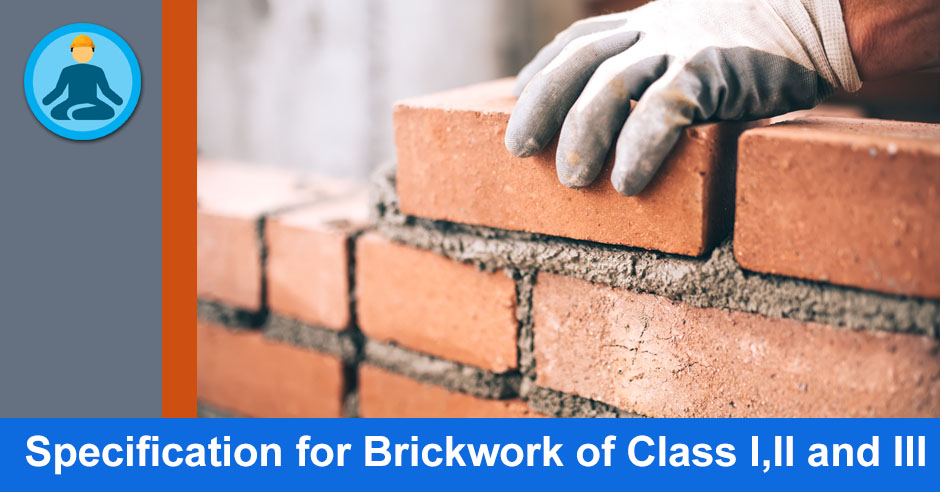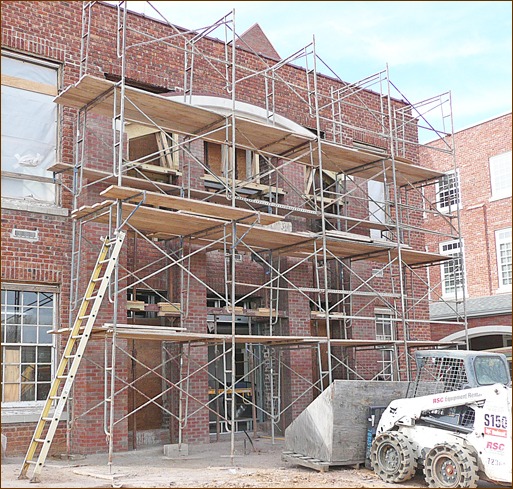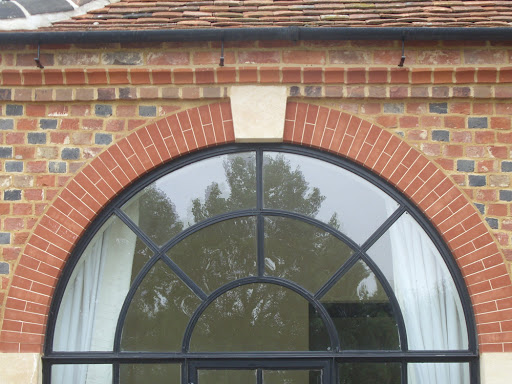To assure high quality of class I brickwork, it is essential to adhere to following specification.

Bricks

- For class I Brickwork, all bricks shall be of first class of standard specifications made of good brick earth.
- Bricks shall be thoroughly burnt, and shall be deep cherry red or copper color.
- Bricks shall be regular in shape and their edges should be sharp.
- Bricks shall emit clear ringing sound on being struck.
- Bricks shall be free from cracks, chips, flaws and lumps of any kind.
- Bricks shall not absorb water more than one-sixth of their weight after one hour of soaking by immersing in water.
- Bricks shall have minimum crushing strength of 105 Kg per Sq. cm. (1500 lbs per sq. in.)
- For class II Brickwork, bricks shall be of second class.
- For class III Brickwork, bricks shall be of third class if otherwise not specified.
Cement Mortar
Mortar shall be specified and materials of mortar shall be of standard specifications.
- For cement mortar, cement shall be fresh portland cement of standard specifications.
- Sand shall be sharp, clean and free from organic and foreign matters.
- For rich mortar, coarse or medium sand should be used.
- For weak mortar, local fine sand may be used.
- Proportion of cement sand mortar may be of 1:3 to 1:6 as specified.
- Materials of mortar shall be measured to have the required proportion with measuring box.
- Materials shall be first mixed dry to have a uniform colour in a clean masonry platform.
- Then mix mortar by adding clean water slowly and gradually to have workable consistency and mixed thoroughly by turning at least three times.
- Only freshly mixed mortar shall be used.
- Old and stale mortar shall not be used.
- Mortar for one hour’s work only shall be mixed with water so that the mortar may be used before setting starts.
Lime Surkhi Mortar
- Generally can be used for class II and II Brickwork.
- Lime surkhi (or sand or cinder) mortar if specified shall be mixed in the specified proportion by grinding in mortar mill for at least three hours on the same day of use.
- Lime shall be fresh and slaked and screened at the site of work.
- Fresh mixed mortar shall be used within 24 hours.
- Old and stale mortar shall not be used.
- For small work, hand mixing may be allowed in the same manner as for cement mortar described above.
- Proportion of lime surkhi (or sand or cinder) mortar may be 1:2 to 1:3 as specified.
Soaking of bricks
- For class I Brickwork, bricks shall be fully soaked in clean water by submerging in a tank for a period of 12 hours immediately before use.
- For class II Brickwork, , bricks shall be fully soaked in clean water by submerging in a tank for a period of 3 hours immediately before use.
- For class III Brickwork, bricks shall be dipped in tub of water before use.
- Soaking shall be continued till air bubbling is ceased.
Bricklaying
- Bricks shall be well bonded and laid in English bond unless otherwise specified.
- Every course shall be truly horizontal and wall shall be truly in plumb.
- Vertical joints of consecutive course shall not come directly over one another.
- Vertical joints in alternate course shall come directly over one another.
- No damaged or broken bricks shall be used.
- Closers shall be of clean cut bricks and shall be placed near the ends of wall but not at the other edge.
- Selected best shaped bricks shall be used for face work.
- For class I Brickwork, mortar joints shall not exceed 6 mm (1/4″) in thickness.
- For class II Brickwork, mortar joints shall not exceed 10 mm (3/8″) in thickness.
- For class II Brickwork, mortar joints shall not exceed 12 mm (1/2″) in thickness.
- Brickwork joints shall be fully filled with mortar.
- Bricks shall be laid with frogs upward except in top course where frogs shall be placed downward.
- Brickwork shall be carried out not more than 1 m (3 ft) in height at a time.
- When one part of the wall has to be delayed, stepping shall be left at an angle of 45 degree.
- Corbelling or projections where made should not be more than 1/4 brick projections in one course.
- All joints shall be raked and faces of wall cleaned a the ed of each day’s work.
Curing
- The brick work shall be kept wet for a period of at least 10 days after laying.
- At the end of day’s work, tops of wall shall be flooded with water my making small weak mortar edging to contain at least 25 mm (1 “) deep water.
Protection
- The brickwork shall be protected from the effect of sun, rain, frost etc. during the constructions and up until such time it is green and likely to be damaged.
Scaffolding

- Necessary and suitable scaffolding shall be provided to facilitate the construction of brick wall.
- Scaffolding shall be sound and strong.
- Supports and members of scaffolding shall be strong so as to withstand all loads likely to come upon them.
Measurement
- Brickwork shall be measured in cu m (cu ft).
- Different kinds of brickwork with different mortar shall be taken under separate items.
- The thickness of wall shall be taken as multiple of half brick as half brick 10 cm, 1 brick 10 cm, 1-1/2 brick 30 cm and so on.
- The rate shall be for the complete work including scaffolding and all tools and plants.
Brickwork in arch

- In addition of the above, for brickwork in arch, type of arch – rough arch or axed or gauged arch as the case may be, and the centering of the arch should be specified.
